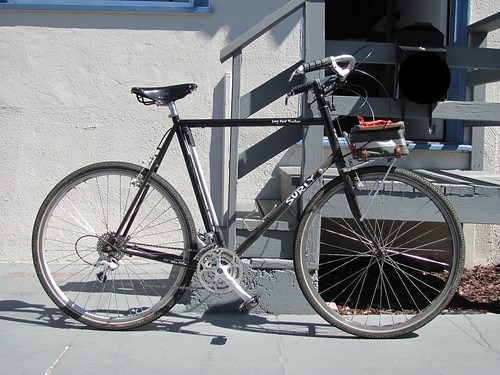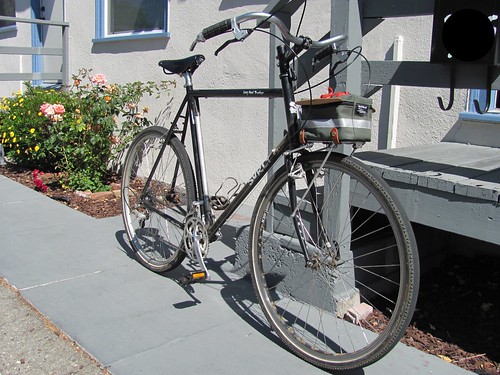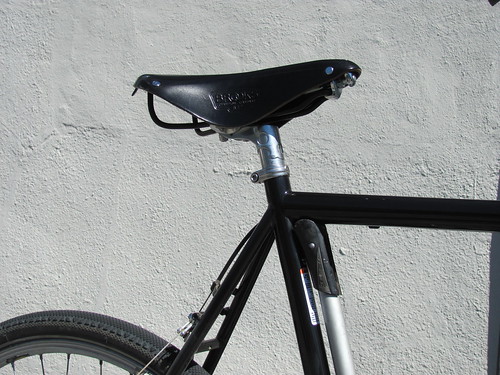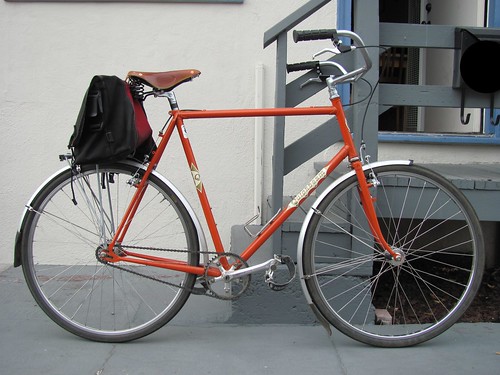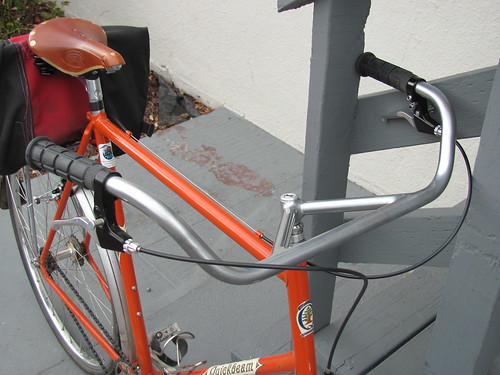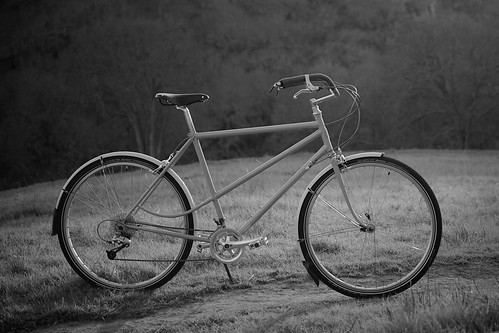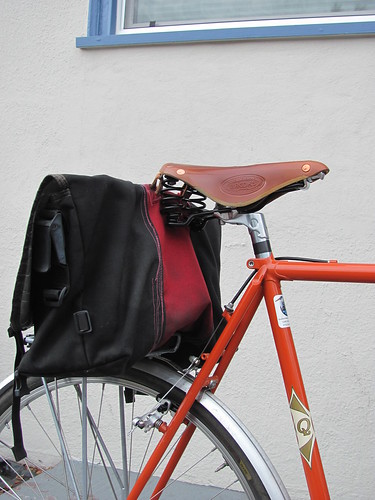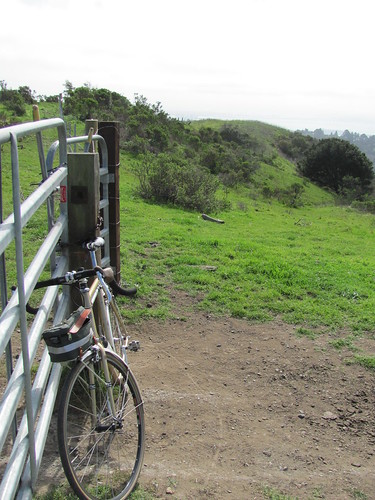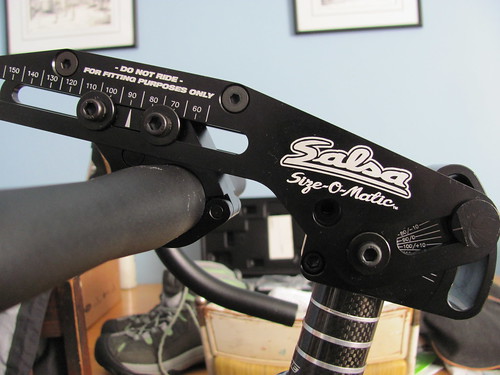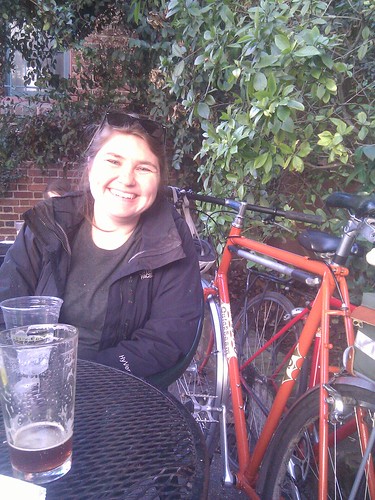
The bike builds and changes of spring and early summer led to some great riding all through the summer; between that and traveling, working, weddings, etc, most of my time's been taken up, which is good for me. Riding has been when I can and where I can, mostly rides of an hour or three up in the Berkeley and Oakland hills, a lot of it in the hours before or after a workday. This kind of riding is the core of my practice as a cyclist and are really what do it for me, I've come to realize. Once in a while I'll get to together with people to do a longer ride or even an all-day epic, but I'm slowly realizing that my fantasies of randos or epic tours don't really reflect my natural inclinations as a cyclist. I try to refocus, appreciate what I have here in the East Bay, close at hand. It really is a great place to ride.
My bike stable has stabilized on three bicycles, and I think that it will stay that way for a while, at least while my wife and I devote most of our resources towards other goals. My three bike stable is:

1. The Trucker. Building up this bike as I have has turned out to be a great addition to my stable. Its present configuration is super versatile. As I said in my original post about it, it's opened up tons of mixed-terrain and off-road riding to me, and I've really enjoyed bombing around the East Bay trails on it. Sometimes I wish for fatter tires or suspension, but the truth is that would make it less capable as an allrounder. With a my Blackburn rear rack bolted up and a pair of Ortleib panniers, I've done a great little overnight trip with Megan on it. In addition to touring capability, its carrying capacity with panniers also means it's a great utility bike, and it's become my go-to for big grocery loads and even trips to Target or the like. Just yesterday it carried a huge grocery load home--it felt like something around 50lbs. I've even done long-ish road rides on it, when I felt like its low gears would come in handy, and haven't felt held back by the lack of drop bars or anything. It's latest upgrade came this week when I finally got my SP SD-8 dynamo hub built into a wheel (laced it 32h 3x to a polished silver Sun CR18 with Wheelsmith 14g spokes, brass nips), and got that mounted up with a good basic LED dyno light from Avenir. With the dyno light, I'm sure it'll see even more use as the days get shorter around here.
This bike has really become something I've sought after with many builds, and mused about on this blog before, but only feel like I've really got it with this one: a true allrounder. Jack of all trades, master of none, but so capable that I wouldn't hesitate to take it anywhere. It's gearing is low enough and it feels efficient enough to tackle long rides and long climbs, but it's also burly enough with fat enough tires that it can handle basically any of the roads or trails I have accessible to me around here. It feels good with a load, but not overly heavy without one. It's got lighting, and it will probably get fenders before too long. It's comfortable and well balanced, and handles really well. As I said before, for any one type of riding, I could see making improvements. A simpler drivetrain, maybe with an internally geared hub, would be better for urban riding. But that would remove some of gear range for the mixed-terrain riding. Offroad, fatter tires and/or suspension might come in handy, but I'd probably regret them on the long road climb up to the trailheads around here. It's pretty awesome as is. If circumstance forced me to have only one bike, chances are that it'd be this one.
At the same time, having the Surly as the designated all-rounder has allowed my other bikes to evolve as well, to become more focused on the types of riding that they are better at than the Surly, and in so doing to become better. So while the Trucker is the allrounder, the one bike I'd have if I'd have to have one, I'd sure miss my other bikes as well.
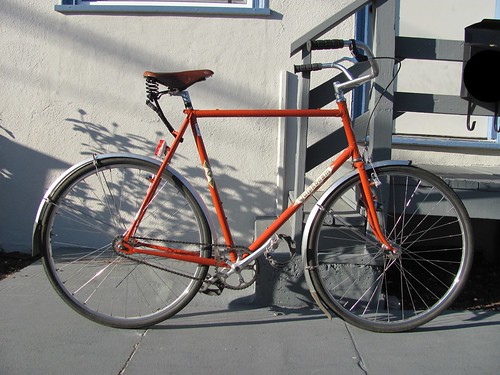
2. The Quickbeam. The Quickbeam has kept it's role as upright, Bosco-barred fixed gear basic transportation bike, but has gotten stripped down a bit. Now that I have the Trucker for big grocery loads, the rack and bag on the Quickbeam have been taken off. For most of my basic riding, to and from work and around Berkeley, I'm only really carrying a lock, waterbottle, and maybe an extra layer, so I get on really well with just my smallest messenger backpack or even just a musette on this bike. Furthermore, the rear brake (and brake lever) have gone along with the freewheel from the flop side of the hub. I'm also running a slightly lower gear (42x19 versus 42x17), which is great for maintaining my cadence heading up the grades towards downtown Berkeley and accelerating from a stop sign, of which there's a lot when you're riding around here. I'm really enjoying the lighter, more bare bones bike. It harkens back to my old fixed gear beaters that were the original inspiration for the bike, and it's focused really well on its purpose.
Stripping off the rear brake lever (as well as removing the vestigial "stopper button" from the remaining front brake lever) has had the added benefit of opening up the hand positions on the Bosco Bullmoose bars. I find myself grabbing a different portion of the long grip area depending on how I'm feeling and how much I'm hustling, including the forward extremities, where it drops down to the horizontal flat section. In fact, holding on to the forward curves, thumbs inward and pointing down (like they would be as you slide your hands forward from the grips and rotate your wrists inward) is a surprisingly ergonomic position. It doesn't sound like it, but it is. I'll have to get a picture of it. I should probably wrap the bars forward of the Oury grips with some cotton tape, but for the moment I don't mind grabbing bare metal, and there's some interesting beausage happening with the nickel plating finish on the bars. I may want the bars wrapped as it gets colder and damper, however.
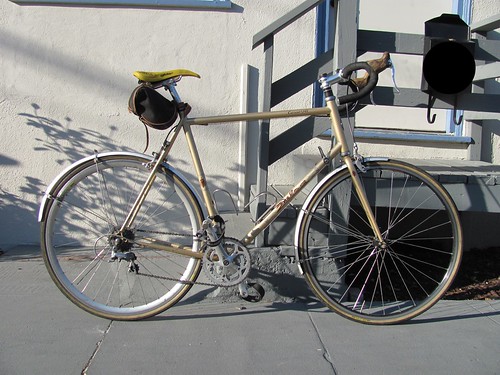
3. The Casseroll. The Casseroll has become my road bike, period. This is the bike I take out when the route is paved and I want to go fast. It's riding position is low down and stretched out, and it is the only one of my bikes at the moment with drop bars. It's great at that, and it's got an eclectic mix of new and not-quite-old-enough-to-be-called-vintage road bike parts that works well for me: long reach brakes for 28mm tires and 35mm fenders, 7spd shimano DT shifters and derailleurs shifting 7 of 8 speeds on a Campagnolo rear wheel, Salsa Cowbell bars, Selle SMP Glider saddle (what can I say, the yellow one was on sale...).
This used to be the bike with which I was search for the "one" fit...the transcendent fit that would be the basis for all of my other fits. In the early part of this year, there was a lot of work on the trainer with levels, measuring tape, a Size-o-Matic stem, and a couple of different saddles mounted way back on a S-84 post searching for it. Truth be told, I wasn't really satisfied with any of the results I got, and I didn't ride this bike a ton in the later spring, around the same time I was discovering riding more upright and building up the Trucker.
And then something interesting happened. The original seatpost I had on the Trucker wasn't working for my, so I cannibalized the S-84 from the Casseroll for it. Wanting to keep three working bikes, just cause it was the first time I'd had three working bikes in years, I just threw the SMP Glider saddle, the last saddle I had been experimenting with, back on using a Thomson seatpost I had in the bin. The Thomson, with a measly 18mm of setback despite its oddly kinked design, gave me probably the farthest forward position on this bike I had tried since I discovered the concept of balance and saddle setback being related.
When I tried it out, low and behold, it didn't feel as horribly unbalanced (weight on hands) as I had remember. Furthemore, the bike felt fast, and I began to really enjoy it's responsiveness. So what, I thought; if this is my fast bike, let me have the position on it which makes me the fastest, even if it might be slightly less comfortable. The Casseroll has become my go-to for a ritual I've taken to calling "Ferrari Friday," where I ride my road bike to work, taking a long detour through the hills on my way there.
Then another thing happened. My wife and I started attending a weekly Beginner Yoga class at a studio near our house. Mostly, we just wanted to get some weeknight exercise together, and I wanted to get some exercise different from bicycling. From the very first class, it was clear that while I'm pretty strong and flexible in certain parts of my body, overall I lack a lot of core strength and flexibility, especially in my hamstrings, pelvis, and lower back. In just a couple of months of going to these classes (and I've definitely missed a few), I've already started to notice a difference in my body, and if nothing else I'm much more aware of my limitations and am working to make them better. In terms of riding, even from the early days of going to class I've noticed a difference in comfort and power on the bicycle, and I notice it most drastically on the Casseroll. I can reach the drops easier, and feel balanced while being able to apply power. It's clear that some of the basic limitations of my body have been a major limiting factor in terms of bike fit, and it's cool to be able to work on that and change my body, little by little.
I still have a long way to go: on the weeks where I don't do Yoga, I can definitely feel it when I hop on this bike. Furthermore, I'm still not 100% satisfied with my position on it. I'm not in pain at all anymore--this is basically a comfortable bike for me now--but there are a couple of things I want to play around with. I find myself sliding forward on the saddle while climbing, which can be annoying with the raised nose on the SMP. The hoods still feel pretty far away. I think the truth is that maybe, this winter, some more trainer fitting work and real-world testing with a yet further forward saddle position might be in order, to help dial in the reach while seeing if I can still feel balanced farther forward. Of course, such a position might be as far forward as I used to ride on this bike, with standard seatposts and saddles, and the truth is I've never felt 100% fitted properly on this thing. What might be different now? Three things: One, I'm using a shorter reach stem and bars than I ever have in the past, meaning I might not need to shove my butt back as far to balance. Two, I've started using plain sneakers on platform pedals (MKS Touring Lite) with Power Grips as foot retention, rather than my old SIDIs with Time ATAC clipless pedals, and have naturally moved to a more midfoot riding position, and consequently a lower saddle height, which helps me feel more balanced overall. Finally, the core strength and flexibility work I'm doing with Yoga mean that a lot of limitations I had before are slowly getting better.
I'm still not convinced that the rather long effective top tube on this bike (60.5cm) is right for me, and I wonder about trying a road bike with a shorter top tube. Just yesterday I discovered this site in the UK, and started fantasizing about something classic and lugged, with a nice short top tube...even the older ones with 120mm spacing, I could use one of those cool new 120mm cassette hubs hitting the market....ahh....hmmm...........
*snaps back to attention*
The truth is, because of some other priorities in my life right now, any major bike projects will probably wait for a year or two, so this is my stable as it will be for a while. And I'm pretty satisfied with it.
